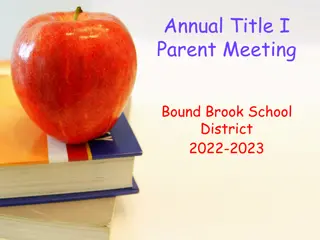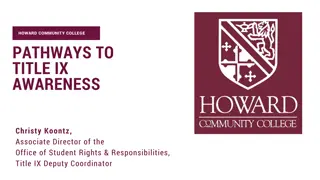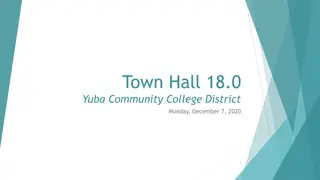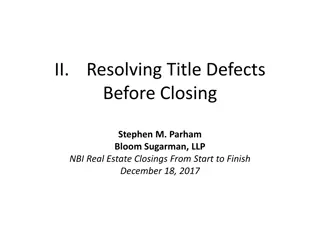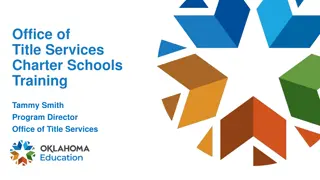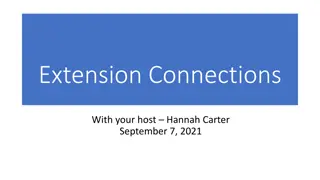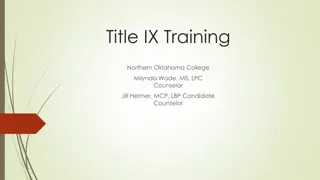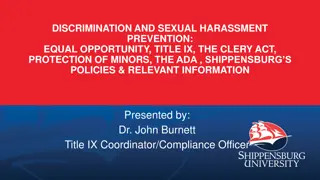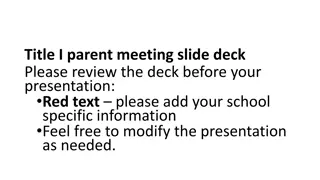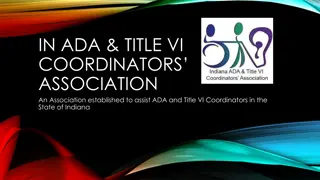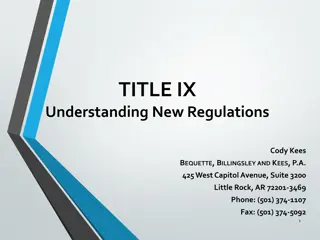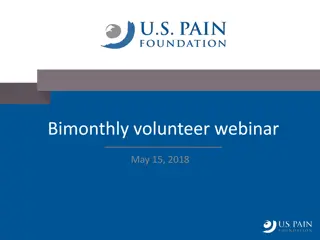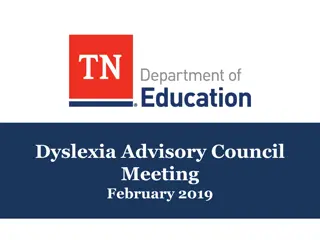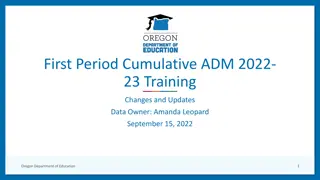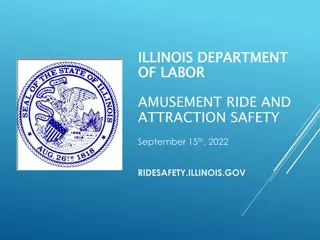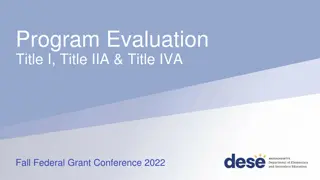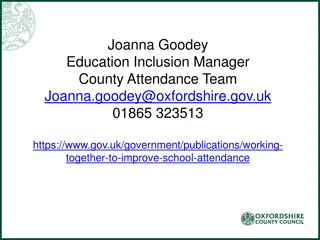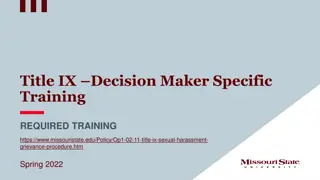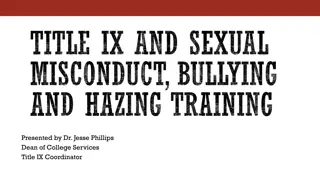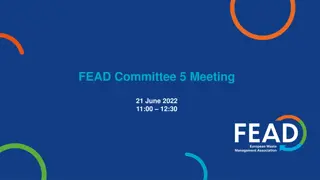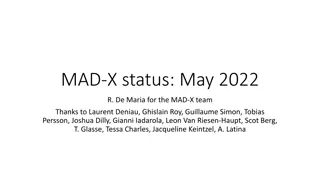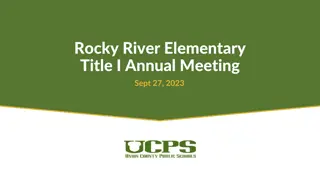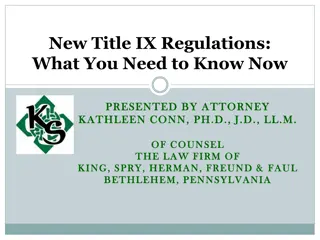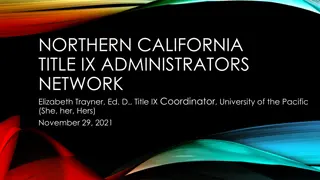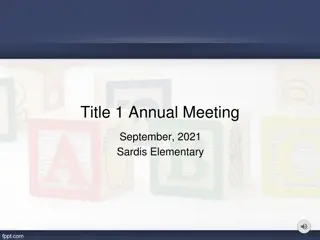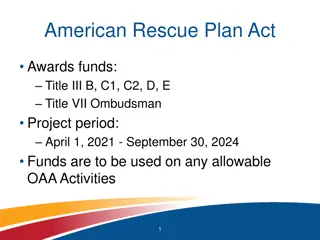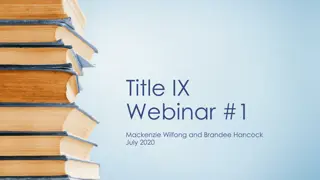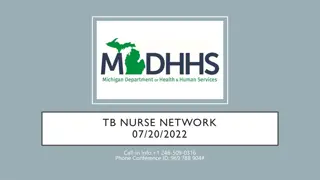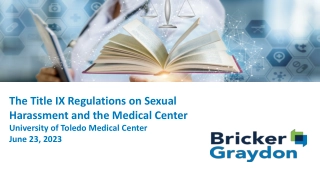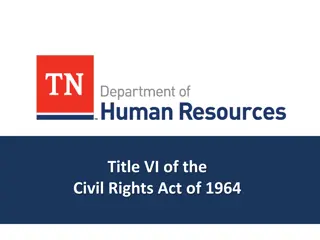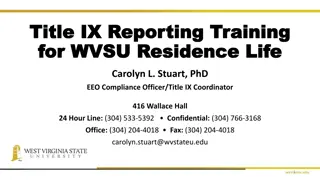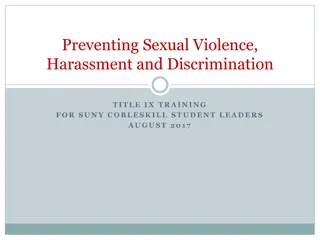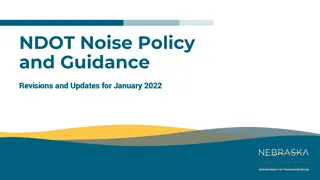Title IX Team Training Overview & Updates 2022
The Title IX Team Training held on January 24, 2022, covered various topics including Introduction of New Team Members, 2020 Regulation Updates, S.P.O.O.C Case Studies, Investigation Reports, Stalking Awareness, and What's Next in the agenda. The session highlighted the importance of non-discrimination based on sex in education programs receiving Federal financial assistance. It discussed the redefined sexual harassment categories under Title IX regulations and the impact of the narrowed definition set by the Department of Education.
Download Presentation

Please find below an Image/Link to download the presentation.
The content on the website is provided AS IS for your information and personal use only. It may not be sold, licensed, or shared on other websites without obtaining consent from the author. Download presentation by click this link. If you encounter any issues during the download, it is possible that the publisher has removed the file from their server.
E N D
Presentation Transcript
Title IX Team Training January 24, 2022
Introduction of New Team Members 2020 Regulation Updates S.P.O.O Case Studies The Investigation Report Special Topics: Stalking Awareness Questions/What s Next AGENDA No person in the United States shall, on the basis of sex, be excluded from participation in, be denied the benefits of, or be subjected to discrimination under any education program or activity receiving Federal financial assistance.
New Team Members Investigators Ross Bradley, Provost s Office Leah Ford, Student Affairs Bailey Gambill, Student Affairs Dan Shelton, Ottenheimer Library Shelia Brooks, Nursing Erin Flowers, DCSTEM Barbara Brewer, Records and Registration
New Team Members Hearing Panel Hearing Chair Ross Bradley, Provost s Office Leah Ford, Student Affairs Bailey Gambill, Student Affairs Eruore Oboh, Law School Carolyn Macheak, Ottenheimer Library Melody Weigel, Law School Andre Cummings, Law School Gigi Peters, Midsouth Lauren Wilson, Student Affairs Ross Bradley, Provost s Office Leah Ford, Student Affairs Robert Steinbuch, Law School
UA Little Rock Title IX Team Training 2020 REG UPDATE
Redefining Sexual Harassment The final 2020 regulations redefine sexual harassment under Title IX to include the following three categories: Quid Pro Quo Harassment: instances where a school employee conditions education benefits on participation in unwelcome sexual conduct; or Unwelcome conduct that a reasonable person would determine is so severe, pervasive, and objectively offensive that it effectively denied a person equal access to the school s education program or activity; or Sexual assault, as defined in the Clery Act, 20 U.S.C. 1092(f), and dating violence, domestic violence, or stalking as defined in the Violence Against Women Act, 34 U.S.C. 12291(a).
Impact of the Narrowed Definition The Department of Education redefined sexual harassment for Title IX purposes and narrowed the scope by requiring that unwelcome conduct be severe and pervasive and objectively offensive (one alone no longer suffices) in a manner that effectively denies an individual access to a school s education program or activity. However, the Final Rule simultaneously broadened the scope of covered actions to now include dating violence, domestic violence and stalking.
Prohibited Under Title IX Sexual Misconduct Rape, Sexual Assault Stalking Dating Violence Emotional, Verbal Retaliation Actions against anyone reporting or participating in a Title IX investigation Sexual Harassment Inappropriate touching, patting, or pinching Physical assault or coerced sexual activity Demands or subtle pressure for sexual favors Unwanted phone calls, texts, email, or gestures
Equity Throughout the Process A balanced and fair process that provides the same opportunities to both parties is required. Various forms of notice policies and procedures, investigation, hearing outcome (finding and sanction), etc. Opportunities to present witnesses and provide evidence If witnesses aren t interviewed, rationale must be given Ability to discuss the allegations without restriction No gag orders allowed; We can t tell parties that they can t discuss the case. Ability to inspect and review evidence and investigation report Provide the same rights for an Advisor Impartial investigators, investigation, hearing, and decision-makers Remedies All parties are entitled to an appeal
Updates to the 2020 Regs Cardona/August 2021 The court vacated that prohibits a decision-maker from relying on statements that are not subject to cross-examination during the hearing: If a party or witness does not submit to cross-examination at the live hearing, the decision- maker(s) must not rely on any statement of that party or witness in reaching a determination regarding responsibility . 2022 Reg Updates The Fall 2021 Unified Agenda and Regulatory Plan, published on December 10, 2021, states that the Department anticipates issuing a notice of proposed rulemaking by April 2022, a month earlier than the May 2022 date in the Spring 2021 Unified Agenda. Today's step reflects the Department's commitment to work as speedily as possible toward appropriate and effective regulation in recognition of the importance of ensuring equal access to education for all students and addressing the threat to equal access posed by all forms of sex discrimination, including sexual harassment.
United States Court of Appeals for the Third Circuit recently revived a lawsuit against Millersville University, finding for the first time that a university may be held liable under Title IX for acts perpetrated by a non-student The policy also required the University to contact victims of domestic violence on campus. Hall was never contacted by the University. The Hall case appears to be the first time a federal appeals court has found that a Title IX funding recipient can be liable for deliberate indifference to sexual harassment perpetrated by a non-student guest on campus. Highlights the importance of the roles mandated reporters play on campuses. Title IX in the News Federal Court Finds Educational Institutions Can Be Held Liable Under Title IX for Actions of Non-Students
What is SPOO? Three categories of sexual harassment under 2020 Title IX Regulations: Quid Pro Quo Harassment: instances where a school employee conditions education benefits on participation in unwelcome sexual conduct; or Unwelcome conduct that a reasonable person would determine is so severe, pervasive, and objectively offensive that it effectively denied a person equal access to the school s education program or activity; or Sexual assault, as defined in the Clery Act, 20 U.S.C. 1092(f), and dating violence, domestic violence, or stalking as defined in the Violence Against Women Act, 34 U.S.C. 12291(a).
What is SPOO? Factors to Consider for Sexual Harassment The elements of severity, pervasiveness, and objective offensiveness must be evaluated in light of the known circumstances and depend on the facts of each situation, but must be determined from the perspective of a reasonable person standing in the shoes of the complainant. The Davis standard does not require an intent element. In other words, unwelcome conduct that is so severe, pervasive, and objectively offensive that it denies a person equal educational opportunity is actionable sexual harassment regardless of the respondent s intent to cause harm. The Department explicitly rejected a should have known standard because, in the Department s view, it creates a negative incentive for Title IX Coordinators and officials with authority to inquire about possible sexual harassment in ways that invade the privacy and autonomy of students and employees. The burden to describe or prove elements does not fall on complainants, but rather on recipients to evaluate reports of sexual harassment using their common sense.
Is it S.P.O.O? Case Study While in Complainant s residence hall room, Respondent allegedly engaged in unwelcome touching, kissing, and taking pictures of Complainant s feet all while Complainant was intoxicated and asleep. Respondent allegedly promised to provide alcohol to the Complainant in order to gain access to Complainant s room. Respondent then over-served Complainant alcohol until he passed out. The Respondent has also been the subject of complaints about several incidents of touching others feet in public without consent.
Is it S.P.O.O? Case Study During class, a Professor assigned homework that required students to watch a show on Netflix that depicts numerous sexual acts (including same sex acts, which the complaining student mentioned as one of their objections to the assignment), nudity, drug use, suicide, marital infidelity, etc. The student found the content to be disturbing. The student is a devout Catholic and was so appalled they went to confession and reported the matter to the Title IX Coordinator. The department chair informed the Title IX Coordinator that the Netflix show did not meet any learning objectives and the professor could have chosen a variety of content through university resources.
Is it S.P.O.O? Case Study A female student used SnapChat to ask a male student to have sex with her. He refused. She then responded that she would rape him if he did not have sex with her. He took a screenshot and brought a complaint against her. As a result of the exchange, he is avoiding her on campus and dropped the class in which they were both enrolled.
Is it S.P.O.O? Johnny and Mary live next door to one another on a co-ed res hall floor, and Mary complains that Johnny watches pornography in his room very loudly, and that she can hear the videos very clearly through the walls. In fact, she believes Johnny intentionally watches porn at an increased volume when he knows Mary is home. Sometimes if she leaves, Johnny seems to pause the pornography, pokes his head out of his room, watches her walk down the hallway, and she can hear him then return to watching porn. On Tuesday, Mary caught Johnny staring at her while she returned from the showers. She confronted him about this, and he said, I m just getting a mental image. She could then hear him immediately start watching porn in his room. Later, Johnny said to Mary, Thanks for earlier, and smiled. Mary and several of her male and female floor mates (who also are upset with the pornography audio levels) file complaints with the TIXC.
Is it S.P.O.O? Professor Tom becomes increasingly informal with his class throughout the semester, both with male and female students. Some students describe Professor Tom as being a bit creepy with the female students. And some male students say Professor Tom stays after class and chats with the male students about which female students are hot. According to one male student, Professor Tom called one female student, Mary, a hot piece of ass in a conversation with him and one other male student. The next week Professor Tom told the whole class that his girlfriend is very experienced in the bedroom, and that he doesn t use condoms because none of them fit him right. That same day, he asked Mary to stay after class, and with several other students still in the room, told Mary that he knew she had been partying a lot, that she should be careful, and he gave her his cell number in case she ever needed help or a ride home at night. As he told her this, he brought his hand into contact with her back and down to the small of her back, leaving his hand in contact with her for 5-10 seconds just above her buttocks. Mary made a complaint about his inappropriate attention and contact.
Is it Quid Pro Quo? Professor Doug and student Cindy have grown fairly close throughout the semester, and according to others, their relationship seems inappropriate and overly flirtatious. Many students believe Cindy (who is not a very good student) is flirting with Professor Doug to garner favor from him, as Professor Doug is extremely influential in this academic field. Finally, one day, Professor Doug tells Cindy that if she has sex with him, he will give her an A-grade. Cindy welcomes this offer, and she has sex with Professor Doug. She receives an A-grade, and it propels her into an internship and ultimately her dream job. To this day, Cindy says that having sex with Professor Doug was the best decision she ever made and is very happy with how her life and career turned out as a result. No other student ever becomes aware of this arrangement, and there was no grade curve, thus, no other student s grade was affected. Without worrying about the fact that Professor Doug s behavior is concerning as it could be repeated, is this one particular incident quid pro quo sexual harassment?
UA Little Rock Title IX Team Training The Investigation Report
The Process Formal Initial Assessment Determination (Hearing) Incident Appeal Investigation and Report Notice to parties Identification of witnesses Interview Scheduling Evidence Collection Report Drafted Evidence and draft investigation report shared Investigation report finalized and shared Complaint or notice to the Title IX Coordinator Strategy Development Jurisdiction Dismissal? Policy violation implicated? Reinstatement? Informal or Formal Resolution? Cross-examination Determination Sanction? Remedies Standing Vacate? Remand? Substitute?
Report Writing This document reflects the careful work done throughout the investigation. Clear, concise, can withstand scrutiny Comprehensive document summarizing the investigation that includes Results of interviews Summary of other information collected
Investigation Report An Investigation report will detail the investigation in the following sections: Relevant Background Jurisdiction and Scope of the Investigation Applicable UA Little Rock Policies and Relevant Definitions Investigation Timeline Reported Incident Timeline(s) Summary of Relevant Statements and Evidence Credibility Assessment Discussion and Synthesis Conclusion Appendices
G.A.S. Framework Synthesize areas of dispute/agreement and all questions asked Assess Gather Evidence credibility and evidence Assess Gather Synthesize
Understanding Evidence Formal rules of evidence do not apply All relevant and reasonably available evidence must be considered inculpatory and exculpatory If the information is considered relevant to prove or disprove a fact at issue, it should be admitted. If credible, it should be considered. Evidence is any kind of information presented with the intent to prove what took place Certain types of evidence may be relevant to the credibility of the party or witness, but not to the allegations
G.A.S. Framework Synthesize areas of dispute/agreement and all questions asked Assess Gather Evidence credibility and evidence Assess Gather Synthesize
To assess credibility is to assess the extent to which you can rely on an individual s testimony to be accurate and helpful in your understanding of the case. Credible is not synonymous with truthful. Memory errors do not necessarily destroy witness credibility, nor does some evasion or misleading Refrain from focusing on irrelevant inaccuracies and inconsistencies CREDIBILITY Credibility is largely a function of corroboration and consistency.
Credibility Assessment Example Incorrect Mark, the Respondent, was less credible than Mariana, the Complainant, or The decision-maker should find Mark to be unbelievable in his testimony about having received consent for the following reasons... That s not assessment, it s analysis. It goes too far. Correct Mark s testimony about X contrasts with Mariana s testimony about X, and the accounts of Witness 1 and Witness 7 aligned with Mariana s testimony, not Mark s, during the investigation. That s not a conclusion, but it is an assessment of the evidence
Inherent Plausibility Does this make sense? Be careful of bias influencing sense of logical Motive to Falsify Do they have a reason to lie? Corroboration Aligned testimony and/or physical evidence Past Record Is there a history of similar behavior? Demeanor (use caution!) Do they seem to be lying or telling the truth? CREDIBILITY Credibility is largely a function of corroboration and consistency.
Assessing Evidence Some steps that may be helpful: When reviewing all interview notes and materials, list the unanswered questions or information that needs clarification. Make a list of uncontested and contested information, then determine which of the uncontested information is most supported by the preponderance of the evidence. Obtain additional needed information, if possible. List the facts relevant to the allegation(s) that must be true for the allegation(s) to be supported. List supporting/corroborating data for each fact. Evidence presented by a person of authority should be given no more credibility than evidence from a student. Don t confuse seniority or hierarchy with expertise. An expert witness should only be permitted to testify on areas of their expertise.
1 2 3 Only evidence that is directly related to the complaint (but is determined by the Investigators not to be relevant). All evidence that is neither relevant nor directly related to the complaint. All evidence that is relevant to the complaint. The Three Buckets of Evidence
Relevant and Directly Related Evidence Evidence is generally considered relevant if it has value in proving or disproving a fact at issue While directly related evidence is not defined by the regulations, it may be helpful to think of it as evidence connected to the complaint, but which is not inculpatory or exculpatory, and/or which is explicitly excluded by the regulations Under the TIX regulations, evidence of the Complainant s sexual predisposition is never relevant Evidence of the Complainant s prior sexual behavior is explicitly and categorically not relevant except for two limited exceptions: Offered to prove that someone other than the Respondent committed the conduct alleged, or Concerns specific incidents of the Complainant s sexual behavior with respect to the Respondent and is offered to prove consent The regulations do not require the same analysis applied to the Respondent so that consideration of pattern behavior is possible
Separating Evidence Investigation Report = Only Relevant Evidence Evidence File = All Relevant Evidence and Directly Related Evidence (DRE) The report is the narrower document, and the evidence file is a broader file When a portion of an interview/document/etc. is relevant, and another portion is DRE, the content needs to be separated Color code the evidence in the evidence file -or- Add footnotes or internal notes to organize the evidence
Separating Evidence Example Parties exchanged 36 text messages; each writing 18 Investigator(s) determines that 20 messages are relevant and 16 are DRE Investigator(s) include 20 in the report, noting that a section of texts is redacted and references where in the evidence file the redacted texts can be found Investigator(s) provide the entire text threat but uses color coding to show sections that are relevant/DRE Thus the reader has the entire context, but can clearly see what evidence has been deemed relevant and what has not 36 Text Messages Evidence File 16 Directly Related Messages 20 Relevant Text Messages Investigation Report Evidence File
G.A.S. Framework Synthesize areas of dispute/agreement and all questions asked Assess Gather Evidence credibility and evidence Assess Gather Synthesize
Discussion and Synthesis Step 1: The first list is a summary of all undisputed evidence upon which the parties/witnesses are in agreement. The second list summarizes all the evidence that remains contested between the parties/witnesses. Step 2: A synthesis of all questions, which This likely takes the form of an appendix to the report, in which the investigator(s) summarizes questioning in a three-column table. Column 1: All Questions Asked Column 2: All Questions Suggested Column 3: Explain whether questions were posted to all parties
Discussion and Synthesis Discuss and Synthesize the relevant information Consider the elements of each policy at issue Refer back to the relevant evidence cited Refer to the credibility assessment(s) Summarize all areas of contested and uncontested facts and evidence. The parties agree on The parties disagree about the following
UA Little Rock Team Training BIAS, CONFLICTS OF INTEREST, & RECUSAL
Conflicts of Interest and Bias Impartiality is integral to the Title IX process. Serving impartially includes avoiding: Prejudgment of the facts at issue Conflicts of interest Bias Treat all participants equally; make no assumptions about the allegations based on the demographics of participants.
Bias Bias can represent any variable that improperly influences a decision Forms of bias and prejudice that can impact decisions: Pre-determined outcome Partisan approach by investigators in questioning, analysis, or report Partisan approach by decision-makers in questioning, findings, or sanctions Intervention by senior-level administrators, or external sources Not staying in your lane Improper application of institutional policies or procedures Confirmation bias Implicit bias Animus of any kind, including race, religion, disability, etc.
Bias and Conflict of Interest Types of conflicts/bias: Wearing too many hats in the process Legal counsel as Investigator or Decision-maker Decision-maker who is not impartial Biased training materials; reliance on sex or gender stereotypes Simply knowing a student or an employee is typically not sufficient to create a conflict of interest if objectivity not compromised Also, having disciplined a student or employee previously is often not enough to create a conflict of interest
Recusal Conflict of interest might necessitate recusal, or party may request it Identify and train an alternate Decision-maker/Chair Procedures should define the process and circumstances by which a party may seek to recuse a Decision-maker Typically the Title IX Coordinator determines whether recusal is necessary If you feel you cannot hear a case impartially, notify Title IX Coordinator immediately
UA Little Rock Title IX Team Training SPECIAL TOPICS
Stalking is a pattern of behavior directed at a specific person that would cause a reasonable person to fear for the person s safety or the safety of others; or suffer substantial emotional distress. Stalking is criminal, traumatic, dangerous and often misunderstood. About half of stalking cases are related to intimate partner violence which means that half are not. Stalking can happen with acquaintances, strangers, and family members. JANUARY is STALKING AWARENESS MONTH
Pattern of Behavior How many incidents make a pattern? Two or more incidents make a pattern. What types of behaviors are considered stalking? Stalkers use a variety of tactics, including (but not limited to): unwanted contact including phone calls, texts, and contact via social media, unwanted gifts, showing up/approaching an individual or their family/friends, monitoring, surveillance, property damage, and threats. What if the stalker s actions aren t illegal? For example, sending gifts Stalking is a crime in Arkansas; Even if the behavior is not a crime on its own (like texting excessively), it may be part of the pattern of stalking behavior and victims should consider documenting and reporting it.
Stalking or Harassment? Stalking and harassment are similar and can overlap. Harassment may be part of a stalking pattern of behavior/course of conduct. Generally, the element of fear is what separates stalking from harassment. Harassment is typically irritating and bothersome, sometimes to the point where a victim feels deeply uncomfortable. However, victims of harassment are not typically afraid of their perpetrators. For example, a colleague who consistently mocks a new coworker for her appearance may be harassing her by saying cruel things and sending disparaging e-mails. While the victim is distressed and may feel sad, anxious, angry and/or uncomfortable, she is not afraid of the perpetrator she does not believe that the behaviors will escalate or that further harm will come to her. However, if that same perpetrator began calling the victim s cell phone, following the victim and/or posting disparaging things about the victim online, it could become stalking.
UA Little Rock Title IX Policy Form of Sexual Harassment Stalking. Engaging in a course of conduct directed at a specific person that would cause a reasonable person to fear for his or her safety or the safety of others or suffer substantial emotional distress. https://ualr.edu/policy/home/facstaff/title-ix/
Resources Stalkingawareness.org https://www.justice.gov/ovw/stalking https://www.whitehouse.gov/briefing- room/presidential-actions/2021/12/30/a- proclamation-on-national-stalking- awareness-month-2022/
UA Little Rock Title IX Team Training Questions?



